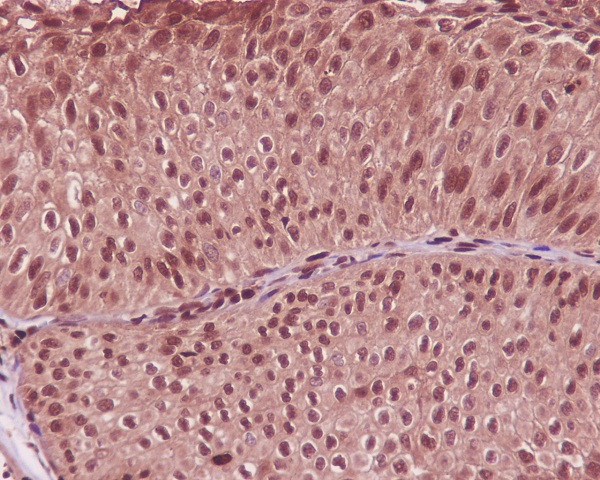| Western blot (WB): | 1:2000-20000 |
| Immunohistochemistry (IHC): | 1:50-200 |
| Immunocytochemistry/Immunofluorescence (ICC/IF): | 1:50-200 |
| Flow Cytometry (FCM): | 1:50 |

Western blot analysis of anti-GAPDH antibody (BM3874). The sample well of each lane was loaded with 30 ug of sample under reducing conditions.
Lane 1: human Hela whole cell lysates,
Lane 2: human K562 whole cell lysates,
Lane 3: human MCF-7 whole cell lysates,
Lane 4: human A549 whole cell lysates,
Lane 5: human PC-3 whole cell lysates,
Lane 6: monkey COS-7 whole cell lysates.
After electrophoresis, proteins were transferred to a membrane. Then the membrane was incubated with rabbit anti-GAPDH antigen affinity purified monoclonal antibody (BM3874) at a dilution of 1:5000 and probed with a goat anti-rabbit IgG-HRP secondary antibody (Catalog # BA1054). The signal is developed using ECL Plus Western Blotting Substrate (Catalog # AR1197). A specific band was detected for GAPDH at approximately 36 kDa. The expected band size for GAPDH is at 36 kDa.

Western blot analysis of anti-GAPDH antibody (BM3874). The sample well of each lane was loaded with 30 ug of sample under reducing conditions.
Lane 1: rat liver tissue lysates,
Lane 2: rat brain tissue lysates,
Lane 3: rat RH-35 whole cell lysates,
Lane 4: mouse liver tissue lysates,
Lane 5: mouse brain tissue lysates,
Lane 6: mouse NIH/3T3 whole cell lysates.
After electrophoresis, proteins were transferred to a membrane. Then the membrane was incubated with rabbit anti-GAPDH antigen affinity purified monoclonal antibody (BM3874) at a dilution of 1:5000 and probed with a goat anti-rabbit IgG-HRP secondary antibody (Catalog # BA1054). The signal is developed using ECL Plus Western Blotting Substrate (Catalog # AR1197). A specific band was detected for GAPDH at approximately 36 kDa. The expected band size for GAPDH is at 36 kDa.

Immunohistochemical analysis of paraffin-embedded human bladder cancer, using GAPDH Antibody.

Western blot analysis of anti-GAPDH antibody (BM3874). The sample well of each lane was loaded with 30 ug of sample under reducing conditions.
Lane 1: human Hela whole cell lysates,
Lane 2: human K562 whole cell lysates,
Lane 3: human MCF-7 whole cell lysates,
Lane 4: human A549 whole cell lysates,
Lane 5: human PC-3 whole cell lysates,
Lane 6: monkey COS-7 whole cell lysates.
After electrophoresis, proteins were transferred to a membrane. Then the membrane was incubated with rabbit anti-GAPDH antigen affinity purified monoclonal antibody (BM3874) at a dilution of 1:5000 and probed with a goat anti-rabbit IgG-HRP secondary antibody (Catalog # BA1054). The signal is developed using ECL Plus Western Blotting Substrate (Catalog # AR1197). A specific band was detected for GAPDH at approximately 36 kDa. The expected band size for GAPDH is at 36 kDa.

Western blot analysis of anti-GAPDH antibody (BM3874). The sample well of each lane was loaded with 30 ug of sample under reducing conditions.
Lane 1: rat liver tissue lysates,
Lane 2: rat brain tissue lysates,
Lane 3: rat RH-35 whole cell lysates,
Lane 4: mouse liver tissue lysates,
Lane 5: mouse brain tissue lysates,
Lane 6: mouse NIH/3T3 whole cell lysates.
After electrophoresis, proteins were transferred to a membrane. Then the membrane was incubated with rabbit anti-GAPDH antigen affinity purified monoclonal antibody (BM3874) at a dilution of 1:5000 and probed with a goat anti-rabbit IgG-HRP secondary antibody (Catalog # BA1054). The signal is developed using ECL Plus Western Blotting Substrate (Catalog # AR1197). A specific band was detected for GAPDH at approximately 36 kDa. The expected band size for GAPDH is at 36 kDa.

Immunohistochemical analysis of paraffin-embedded human bladder cancer, using GAPDH Antibody.




